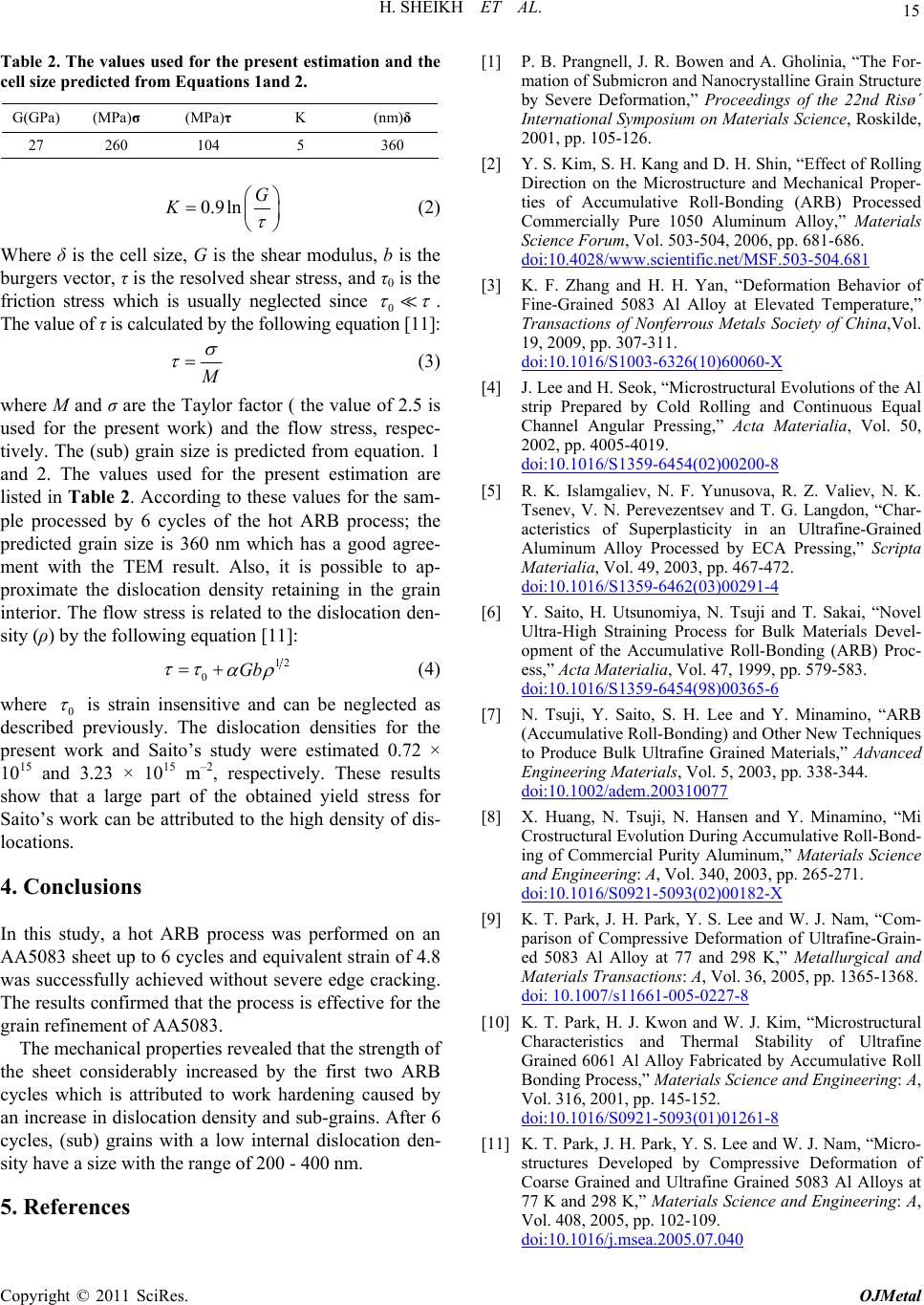
H. SHEIKH ET AL.
Copyright © 2011 SciRes. OJMetal
15
[1] P. B. Prangnell, J. R. Bowen and A. Gholinia, “The For-
mation of Submicron and Nanocrystalline Grain Structure
by Severe Deformation,” Proceedings of the 22nd Risø´
International Symposium on Materials Science, Roskilde,
2001, pp. 105-126.
Table 2. The values used for the present estimation and the
cell size predicted from Equations 1and 2.
G(GPa) (MPa)σ (MPa)τ (nm)δ K
27 260 104 5 360
[2] Y. S. Kim, S. H. Kang and D. H. Shin, “Effect of Rolling
Direction on the Microstructure and Mechanical Proper-
ties of Accumulative Roll-Bonding (ARB) Processed
Commercially Pure 1050 Aluminum Alloy,” Materials
Science Forum, Vol. 503-504, 2006, pp. 681-686.
doi:10.4028/www.scientific.net/MSF.503-504.681
0.9lnG
K
(2)
Where δ is the cell size, G is the shear modulus, b is the
burgers vector, τ is the resolved shear stress, and τ0 is the
friction stress which is usually neglected since 0
.
The value of τ is calculated by the following equation [11]:
[3] K. F. Zhang and H. H. Yan, “Deformation Behavior of
Fine-Grained 5083 Al Alloy at Elevated Temperature,”
Transactions of Nonferrous Metals Society of China,Vol.
19, 2009, pp. 307-311.
doi:10.1016/S1003-6326(10)60060-X
(3)
[4] J. Lee and H. Seok, “Microstructural Evolutions of the Al
strip Prepared by Cold Rolling and Continuous Equal
Channel Angular Pressing,” Acta Materialia, Vol. 50,
2002, pp. 4005-4019.
doi:10.1016/S1359-6454(02)00200-8
where M and σ are the Taylor factor ( the value of 2.5 is
used for the present work) and the flow stress, respec-
tively. The (sub) grain size is predicted from equation. 1
and 2. The values used for the present estimation are
listed in Table 2. According to these values for the sam-
ple processed by 6 cycles of the hot ARB process; the
predicted grain size is 360 nm which has a good agree-
ment with the TEM result. Also, it is possible to ap-
proximate the dislocation density retaining in the grain
interior. The flow stress is related to the dislocation den-
sity (ρ) by the following equation [11]:
[5] R. K. Islamgaliev, N. F. Yunusova, R. Z. Valiev, N. K.
Tsenev, V. N. Perevezentsev and T. G. Langdon, “Char-
acteristics of Superplasticity in an Ultrafine-Grained
Aluminum Alloy Processed by ECA Pressing,” Scripta
Materialia, Vol. 49, 2003, pp. 467-472.
doi:10.1016/S1359-6462(03)00291-4
[6] Y. Saito, H. Utsunomiya, N. Tsuji and T. Sakai, “Novel
Ultra-High Straining Process for Bulk Materials Devel-
opment of the Accumulative Roll-Bonding (ARB) Proc-
ess,” Acta Materialia, Vol. 47, 1999, pp. 579-583.
doi:10.1016/S1359-6454(98)00365-6
12
0Gb
(4)
where 0
is strain insensitive and can be neglected as
described previously. The dislocation densities for the
present work and Saito’s study were estimated 0.72 ×
1015 and 3.23 × 1015 m
–2, respectively. These results
show that a large part of the obtained yield stress for
Saito’s work can be attributed to the high density of dis-
locations.
[7] N
. Tsuji, Y. Saito, S. H. Lee and Y. Minamino, “ARB
(Accumulative Roll-Bonding) and Other New Techniques
to Produce Bulk Ultrafine Grained Materials,” Advanced
Engineering Materials, Vol. 5, 2003, pp. 338-344.
doi:10.1002/adem.200310077
[8] X. Huang, N. Tsuji, N. Hansen and Y. Minamino, “Mi
Crostructural Evolution During Accumulative Roll-Bond-
ing of Commercial Purity Aluminum,” Materials Science
and Engineering: A, Vol. 340, 2003, pp. 265-271.
doi:10.1016/S0921-5093(02)00182-X
4. Conclusions
[9] K. T. Park, J. H. Park, Y. S. Lee and W. J. Nam, “Com-
parison of Compressive Deformation of Ultrafine-Grain-
ed 5083 Al Alloy at 77 and 298 K,” Metallurgical and
Materials Transactions: A, Vol. 36, 2005, pp. 1365-1368.
doi: 10.1007/s11661-005-0227-8
In this study, a hot ARB process was performed on an
AA5083 sheet up to 6 cycles and equivalent strain of 4.8
was successfully achieved without severe edge cracking.
The results confirmed that the process is effective for the
grain refinement of AA5083. [10] K. T. Park, H. J. Kwon and W. J. Kim, “Microstructural
Characteristics and Thermal Stability of Ultrafine
Grained 6061 Al Alloy Fabricated by Accumulative Roll
Bonding Process,” Materials Science and Engineering: A,
Vol. 316, 2001, pp. 145-152.
doi:10.1016/S0921-5093(01)01261-8
The mechanical properties revealed that the strength of
the sheet considerably increased by the first two ARB
cycles which is attributed to work hardening caused by
an increase in dislocation density and sub-grains. After 6
cycles, (sub) grains with a low internal dislocation den-
sity have a size with the range of 200 - 400 nm.
[11] K. T. Park, J. H. Park, Y. S. Lee and W. J. Nam, “Micro-
structures Developed by Compressive Deformation of
Coarse Grained and Ultrafine Grained 5083 Al Alloys at
77 K and 298 K,” Materials Science and Engineering: A,
Vol. 408, 2005, pp. 102-109.
doi:10.1016/j.msea.2005.07.040
5. References